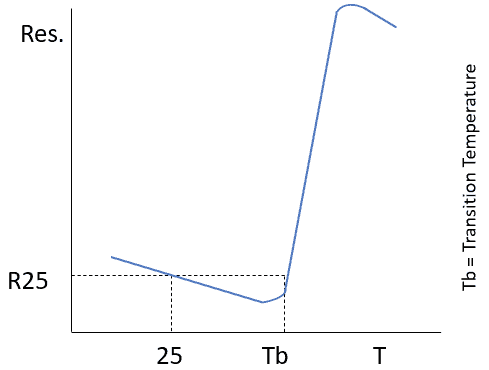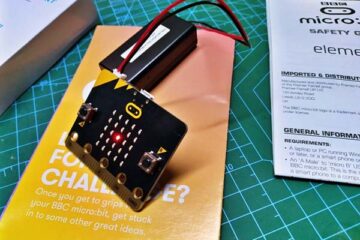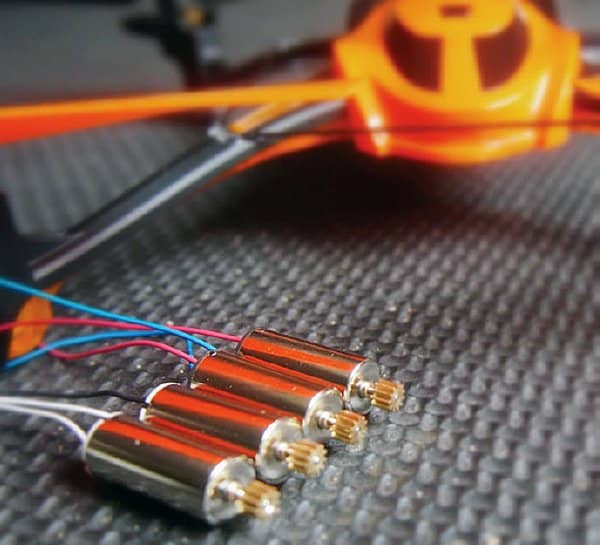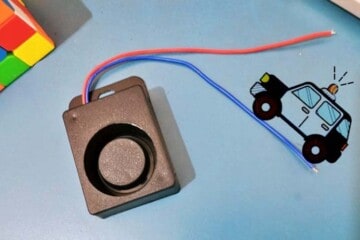This post is a quick introduction to resettable PTCs (PPTCs).
A polymeric positive temperature coefficient device (PPTC) is a passive electronic component used to protect against overcurrent faults in electronic circuits. Simply put, a PPTC device, also known as a multifuse or polyfuse or polyswitch, is actually a resettable fuse!
Simply put, a PPTC device, also known as a multifuse or polyfuse or polyswitch, is actually a resettable fuse!
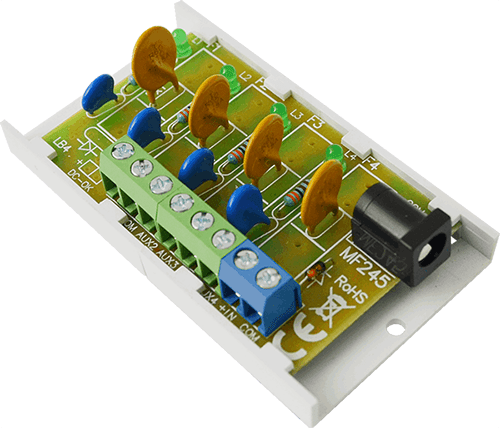
Resettable PTC (PPTC) Fuse – Overview
Positive temperature coefficient (PTC) resettable fuse is a circuit protection device which provides overcurrent and overtemperature protection in a variety of applications. A PTC resettable fuse can open electric circuits during fault events like a traditional one-time fuse, but is automatically resettable.
A PTC fuse consists of a positive temperature coefficient material whose internal resistance increases exponentially with an increase in operating temperature. So, a PTC resettable fuse has two functional states (ON and OFF). In the ON state (tripped state), the device offers very high resistance in response to faults such as short-circuit or overheat, thus limits the current flow through the device until the material cools, then reverts to low resistance mode. In the OFF state (idle state), the device maintains a low resistance as the current is within a safe range (www.eaton.com/electronics).
In other words, a PPTC fuse reaches a high resistance with a low holding current under fault conditions and reverts back to a conductive state after the current is removed, acting more like a circuit breaker, allowing the circuit to function again without replacing anything.
Note at this point that a PPTC device has a current rating so that when the current flowing through the device exceeds the current limit, the PPTC device warms up above a threshold temperature and the device is tripped to cut off the current flow over the circuit. However, after power off and the failure has been eliminated, the device will return to its initial state without any manual operation.
Needless to say, a PPTC device reacts to heat generated by the excessive current flow in the circuit. The resistance vs temperature graph below loosely depicts how it reacts to the temperature changes.
(a little more useful information: https://www.seattleu.edu/media/college-of-science-and-engineering/files/departments/electricalandcomputerengineering/polyswitchTechFundc4cd.pdf).
As an aside, the following technical terms are interchangeable. If not, let me know in the comments.
- Resettable PTC Fuse
- PPTC Fuse
- Resettable PPTC Fuse
- PPTC Resettable Fuse
Resettable PTC Fuse – Essential Terms
The following are a few key terms associated with resettable PTC fuses:
- Voltage Rating (VMAX): The maximum continuous operating voltage the device can withstand without damage at maximum current
- Maximum Current (IMAX):The maximum amount of fault current the PTC can withstand without damage at rated voltage
- Initial Resistance (Ri): The PTC resistance in initial state
- Trip Current (ITRIP): Trip current is the minimum current required to interrupt current flow through the circuit. At this current level, the PTC resettable fuse is heated sufficiently to switch into a high-resistance state
- Hold Current (IHOLD): Hold current is the maximum current the PTC fuse can sustain for long periods of time without tripping
- Trip Time (tTRIP): Trip time is the maximum amount of time taken for the fuse to switch to a non-conducting (high-resistance) state, at the stated trip current, limiting the flow of current through the circuit
- Power Dissipation (PD): The amount of power dissipated by the device during its tripped state
Now keep note that a resettable PTC fuse is not a one-time fuse because there still is a small amount of residual current that flows through the device when in a tripped state where a one-time fuse is designed to permanently open during an overcurrent case!
PTC versus PPTC
A PTC thermistor is a special resistor whose temperature coefficient is positive, since its ohmic value depends on the temperature (specifically increasing at the same rate as it), whereas PPTC is a positive polymer coefficient device, a passive component used in the protection against current peaks in electronic circuits. A PPTC is similar in function to a PTC thermistor, but it operates with mechanical changes instead of charging the effects of the carrier on the semiconductors.
PTC Fuse versus eFuse
Recall, a one shot fuse works based on melting of metal link during high current event. But a PTC resettable fuse heats up when short circuit occurs, and there’s a transition from low resistance state to high resistance state. When power is removed, the device gets cool down to reset to its low resistance state.
The eFuse, however, is an IC protection solution which overcomes limitations of discrete components based circuit protection. The working principle of an eFuse is different than one shot or PTC fuse types as it consists of an FET which limits currents and/or voltages within safe limits during a faulty condition. In principle, an eFuse measures current flowing in the circuit and turn off its internal switch when current exceeds a specified limit.
The NIS5132 from ON Semiconductor is a 12V eFuse which is designed to buffer the load device from excessive input voltage which can damage sensitive circuits. It also includes an overvoltage clamp circuit that limits the output voltage during transients but does not shut the unit down, thereby allowing the load circuit to continue operation. The following block diagram of the NIS5132 series is borrowed from the official datasheet published by ON Semiconductor.
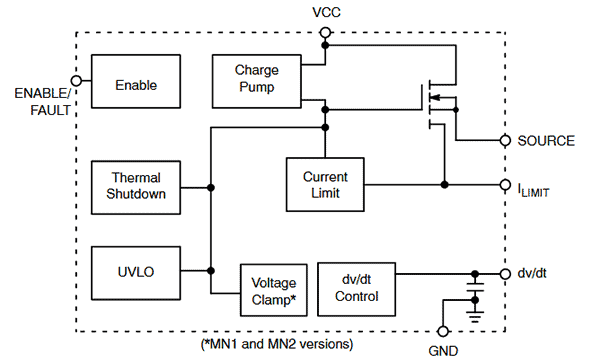
Resettable PTC (PPTC) Fuse – Application Examples
Resettable PTC fuses come in a broad range of footprints, ratings, packaging, and mounting styles suitable for several applications. Coming to their real-world application examples, PTC resettable fuses can provide overload protection in USB ports. PTC fuses can replace one-time fuses to prevent overcharging/overheating in battery packs of low-voltage portable devices, as well. Besides, resettable PTC fuses help to extend the lifespan of DC motors by preventing damage due to thermal overstress in the motor windings during overload conditions or short circuits (see below).
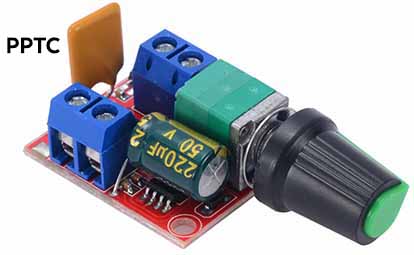
Resettable PTC (PPTC) Fuse – My Story!
I’ve been using resettable PTC fuses in many of my power electronics projects for decades, and my resettable PTC Fuse collection is constantly updated. I’ve a rich stock of various PTC fuses from all the famous brands like RACHEM, BOURNS, LITTLE FUSE, FUSETECH & TYCO.
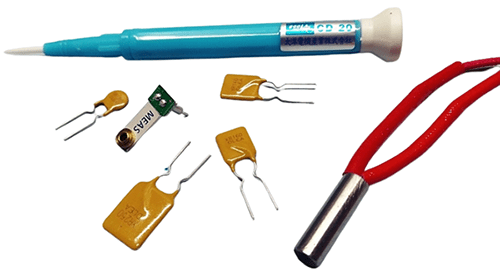
A typical device which I used in the DC power feed segment of a recent USB project is the RUSBF075.
| Part Number | IH (A) | IT (A) | V max. (V) | I max.** (A) | R1 max. (Ω) |
|---|---|---|---|---|---|
| RUSBF075 | 0.75 | 1.30 | 6 | 40 | 0.23 |
Since a visual indication of an error is called for, I also wired a simple “blown fuse indicator” across the resettable PTC fuse. The indicator will only be lit when a short or other fault occurs. Simple, yeh?
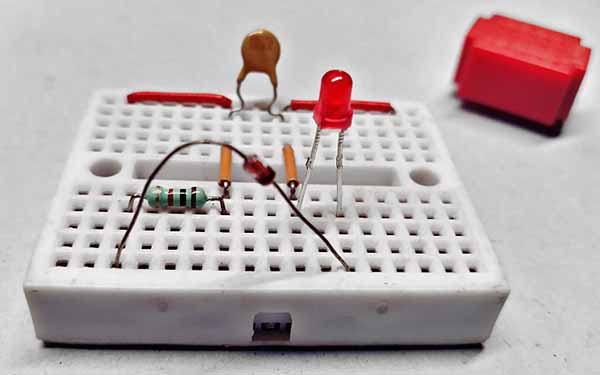
Below you can see the little schematic of my blown fuse indicator.
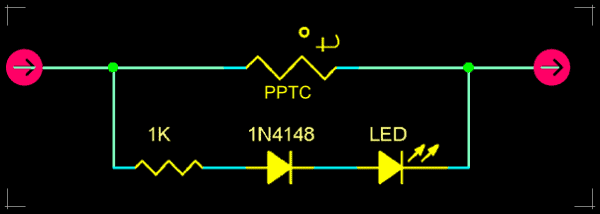
Look, it works well!
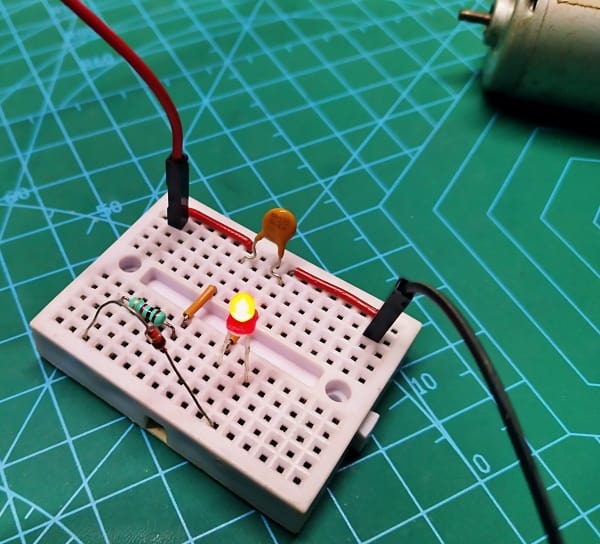
Resettable PTC (PPTC) Fuse – Odd Ideas!
Do you know? PPTC devices can also be used as crude heaters and temperature sensors. In an upcoming article, we will see how to put those funny ideas into practice!


